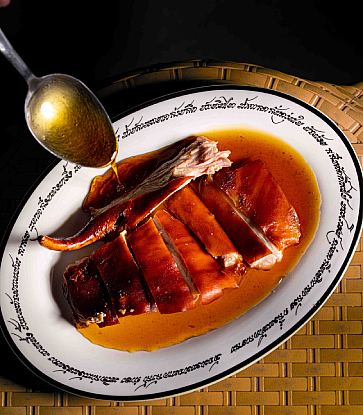When asked what Thai food’s charm is, the answer lies beyond aromas, spiciness, or balanced tastes. It includes the wisdom of ‘food as medicine’, which is not only concerned about medicinal properties of ingredients, but also rotation of ingredients and tastes to stay balanced during seasonal changes.
As seasons change, so do local ingredients and your bodies. ‘Food’ thus becomes the key to keeping your mind and body balanced. Kaeng Som Dok Khae (Sour Katuri Flower Curry) helps with fever when it is turning into a rainy season. Kaeng Kradang (Curry Aspic), a traditional Northern food assortment, provides the fat needed to keep yourself warm during winter. Khao Chae (Rice soaked in water) cools body temperature during summer. Apart from keeping your balance, each seasonal menu also reflects an abundance of local ingredients. Let’s explore noteworthy ingredients and menus you do not want to miss.

Summer Meals
Khao chaeOriginated as a part of Mon people’s Songkran celebration, Khao Chae was popularised in Siam’s royal kitchen during King Rama IV’s reign by Chao Chom Manda Sonklin, a daughter of Phraya Damrong Ratchaphonlakhan of Mon descent. She passed on her knowledge to palace kitchen staff so they could prepare the dish for the king during his summer stays at Phra Nakhon Khiri, a white palace on a mountaintop in the middle of Phetchaburi province. The recipe then became available to commoners, and an iconic dish of the province. Thai Khao Chae becomes greatly different from the original Mon’s recipe. Still, they share the main ingredients including rice, flower-scented water, and varying side dishes.
There are 3 main versions of Khao Chae in Thailand – Khao Chae Phetchaburi, Khao Chae Chao Wang, and Khao Chae Mon. Khao Chae is considered a summer food because, since the old days, the flower-scented water requires complicated preparations to infuse it with coolness. Some use scented candles to add aroma. Some add borneol. But what every recipe follows is to put the water in a clay pot to keep it cool. The water is then sprinkled on the rice, eaten with side dishes that include shrimp paste balls, sweetened fish, stir-fried sweet pickled Chinese turnips, stuffed sweet peppers, stuffed shallots, and etc.
If you visit Phetchaburi, Khao Chae is a common street food available all year round. In Bangkok, you can easily find it around Banglamphu area. But the most popular time for Khao Chae is during April. Many Thai restaurants featured in MICHELIN Guide Thailand 2023 are ready to serve the seasonal Khao Chae Chao Wang. There are Methavalai Sorndaeng (One MICHELIN Star), Saneh Jaan (One MICHELIN Star), and Sanguan Sri (Bib Gourmand) in Bangkok. If you ever find yourself crossing the river to Mon community in Nonthaburi’s Ko Kret, where you can always enjoy Khao Chae Mon, do not miss the opportunity to also try Khao Chae Chao Wang at Suan Thip (One MICHELIN Star).

Thailand’s summer is vibrant with colourful fruits from Eastern provinces. Rambutan, durian, mangosteen, salak, and longkong give the sweetest taste during summer. Every summer, orchards in Rayong, Chanthaburi, Trat offer visitors a fruit buffet, letting them pick fresh fruits straight from the trees. Some communities turn fresh produce into edibles such as salacca chilli paste, salak chilli paste, durian massaman, spicy mangosteen salad, fried durian, green curry with mangosteen, and much more.
Eastern orchards welcome visitors between April and May. Each place has different opening hours and entry fees. Most fruit buffets include tours of the orchards so visitors can also enjoy agrotourism. Fruit-based seasonal dishes are available at restaurants throughout Chanthaburi and Trat. For Bangkokians, you can have the taste of Eastern dishes at restaurants featured in MICHELIN Guide Thailand 2023, including Sri Trat (Bib Gourmand), Burapa (Bib Gourmand), and Supanniga Eating Room (Recommended).

Rainy Season Meals
Cassia CurryWhen it starts raining, local plants sprout and bud. One of the traditional vegetables Thai people love to cook is cassia. There is a saying, ‘a good medicine tastes bitter’. The astringent cassia is thus considered both food and medicine. Its sprouts, buds, and young leaves can be natural sleeping aids and laxatives. Cassia’s sprouts are also high in vitamin C. People in the past consumed them to prevent fever from the changing seasons. To balance out the bitterness, coconut milk, and grilled meat, pork, or fish are added during preparation of cassia curry. Then, Thais eat it with warm rice to make a hearty meal. However, there is an extra step to reduce the natural bitter taste of cassia leaves before you can use them as an ingredient. This contributes to cassia curry’s rare availability. Still, Suan Thip (One MICHELIN Star) highlights this traditional menu as a must-try. The restaurant’s recipe preserves authentic Thai taste. It makes you feel bitterness is delicious.
Mushroom
Rain blesses the land with a multitude of mushrooms. But the more expensive ones are ‘termite mushroom’ and ‘hygroscopic earthstar’. They are well-known produce of Kanchanaburi, the province famous for its spicy wild foods and curries. The ingredients are influenced by the province’s geography where a large forest area lies on the west. Roadside restaurants are offering fresh termite mushroom and hygroscopic earthstar as well as menus containing both mushrooms only during rainy seasons. They fetch high prices because mushroom hunters spend extended periods looking for them in their natural habitat. Boiled termite mushroom is a recommended dish that preserves the natural sweetness. Locals use hygroscopic earthstar to make curry along with sweet leaf, another seasonal vegetable. Some also stir-fry it. The earthstar name in Thai – Het Por – derives from the sound ‘Por’ people hear when they are chewed. Its taste is as sweet as a termite mushroom’s. Apart from Kanchanaburi, Het Por can be found in the Northern and North-eastern part of Thailand. Coccora is another mushroom exclusive to the rainy season.

Winter Meals
Curry AspicWhen the weather turns cold, Northern people cope with a menu that showcases both their kitchen wisdom and food preservation skills. Kaeng Kradang is a traditional dish from the Lan Na era that people still enjoy in Chiang Mai, Chiang Rai, Mae Hong Son, Lampang, Nan, and Lamphun. You will not find any soup in this curry. Instead, pork rind is simmered until its natural gelatine becomes broth, which is then left overnight. The winter air will turn it into chewy jelly. Curry aspic helps you stay warm in the cold. Vendors at various markets wrap it in banana leaves, making it easier to unpack your breakfast. Sometimes, curry aspic becomes a part of traditional food assortment called Khan Tok, a rare treat in modern days.
Short Mackerel
December and January are when short mackerel (Pla Too) from the Gulf of Thailand tastes the sweetest and firmest. The annual ‘Mackerel Festival’ held every December in Samut Songkhram is a guarantee that winter mackerel is the best. Its slogan, roughly translated as ‘cowered head, broken neck’, highlights the signature look of famous Mae Klong mackerel sold in round bamboo crates. Apart from deep-frying and grilling, the mackerel can be an ingredient in sour soup, tom yum, red curry, or spicy salad, showcasing the inexpensive fish’s culinary versatility. Quality mackerel’s habitat spans across the sea of Samut Sakhon, Samut Songkhram, and Phetchaburi. You can visit the MICHELIN-awarded Ruean Panya (Bib Gourmand) whilst visiting Samut Sakhon. Its Boiled Mackerel with Lime might sound and look simple, but the taste is as magical as mum-made dishes that you have to revisit.
These seasonal meals reflect the abundance of Thailand. Every season, each region has something intriguing to offer, waiting for you to come and discover.

Although restrictions are more relaxed, you should still be on guard. Wear a mask, rinse your hands, and look for a SHA certificate that guarantees tourism entrepreneur’s compliance with sanitation measures. The certificate reassures every traveller’s health and safety.
Explore more details on SHA at thailandsha.tourismthailand.org. For updates on travel destinations, contact TAT Call Center 1672, or Facebook TAT Contact Center.













%20-%20Aman%20Nai%20Lert.jpg)
.jpg)




